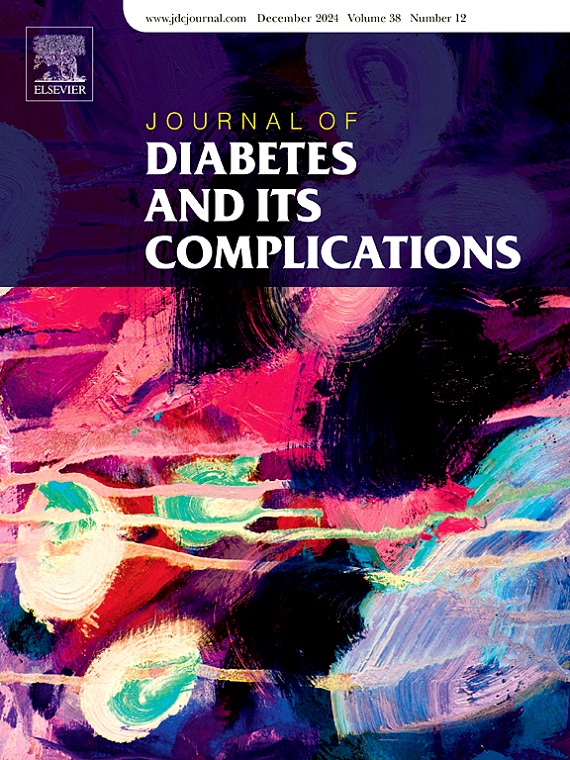NerveCheck master to screen patients with type 1 or type 2 diabetes for peripheral and cardiac autonomic neuropathy
IF 3.1
3区 医学
Q3 ENDOCRINOLOGY & METABOLISM
引用次数: 0
Abstract
Aim
NerveCheck Master (NCKM) is a portable device designed to assess vibration, warm, cold and heat pain perception thresholds. NCKM was shown to offer good diagnostic accuracy for diabetic peripheral neuropathy (DPN). Cardiac autonomic neuropathy (CAN) remains underdiagnosed. We assessed the role of NCKM against Michigan Neuropathy Screening Instrument (MNSI) to screen patients with diabetes for both DPN and CAN.
Methods
DPN was assessed using the 4 NCKM tests and MNSI, and CAN using standard tests, in 76 patients with type 1 (T1DM) and 65 with type 2 diabetes mellitus (T2DM).
Results
Among patients with T1DM and T2DM, DPN prevalence was 26.3 % and 35.4 %, respectively, according to MNSI score (≥2.5), and 61.8 % and 70.8 % according to NCKM (≥2 abnormal tests), and CAN prevalence was 22.4 % and 41.4 %, respectively. Among patients with T1DM, CAN prevalence was markedly higher in those with DPN according to NCKM than in those without (31.9 % vs 6.9 %, p = 0.011), with a far lesser difference among patients with T2DM. The cut-off of two abnormal tests offers good sensitivity and negative predictive value for the detection of patients with CAN, particularly among patients with T1DM (88.2 % and 93.1 %, respectively).
Conclusion
NCKM detects more patients with DPN and its positivity is associated with a higher likelihood of CAN. Using NCKM appears an attractive approach to identify patients to screen for CAN and to improve the yield of CAN tests.
NerveCheck大师筛选1型或2型糖尿病患者周围和心脏自主神经病变
AimNerveCheck Master (NCKM)是一种便携式设备,用于评估振动、温暖、寒冷和热痛感知阈值。NCKM对糖尿病周围神经病变(DPN)具有良好的诊断准确性。心脏自主神经病变(CAN)仍未得到充分诊断。我们评估了NCKM对密歇根神经病变筛查仪(MNSI)筛查糖尿病患者DPN和CAN的作用。方法对76例1型糖尿病(T1DM)患者和65例2型糖尿病(T2DM)患者采用4项NCKM试验和MNSI评价sdpn,采用标准试验评价CAN。结果T1DM和T2DM患者中,根据MNSI评分(≥2.5),DPN患病率分别为26.3%和35.4%,根据NCKM(≥2项异常检查),DPN患病率分别为61.8%和70.8%,CAN患病率分别为22.4%和41.4%。根据NCKM,在T1DM患者中,DPN患者的CAN患病率明显高于无DPN患者(31.9% vs 6.9%, p = 0.011),而T2DM患者的差异要小得多。两项异常检测的截止值对CAN患者,特别是T1DM患者的检测具有良好的敏感性和阴性预测值(分别为88.2%和93.1%)。结论nckm在DPN患者中检出率较高,且其阳性与CAN的发生可能性较高相关。使用NCKM似乎是一种有吸引力的方法来识别患者筛选CAN和提高CAN测试的产量。
本文章由计算机程序翻译,如有差异,请以英文原文为准。
求助全文
约1分钟内获得全文
求助全文
来源期刊

Journal of diabetes and its complications
医学-内分泌学与代谢
CiteScore
5.90
自引率
3.30%
发文量
153
审稿时长
16 days
期刊介绍:
Journal of Diabetes and Its Complications (JDC) is a journal for health care practitioners and researchers, that publishes original research about the pathogenesis, diagnosis and management of diabetes mellitus and its complications. JDC also publishes articles on physiological and molecular aspects of glucose homeostasis.
The primary purpose of JDC is to act as a source of information usable by diabetes practitioners and researchers to increase their knowledge about mechanisms of diabetes and complications development, and promote better management of people with diabetes who are at risk for those complications.
Manuscripts submitted to JDC can report any aspect of basic, translational or clinical research as well as epidemiology. Topics can range broadly from early prediabetes to late-stage complicated diabetes. Topics relevant to basic/translational reports include pancreatic islet dysfunction and insulin resistance, altered adipose tissue function in diabetes, altered neuronal control of glucose homeostasis and mechanisms of drug action. Topics relevant to diabetic complications include diabetic retinopathy, neuropathy and nephropathy; peripheral vascular disease and coronary heart disease; gastrointestinal disorders, renal failure and impotence; and hypertension and hyperlipidemia.
 求助内容:
求助内容: 应助结果提醒方式:
应助结果提醒方式:


